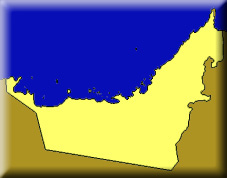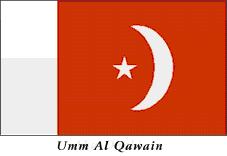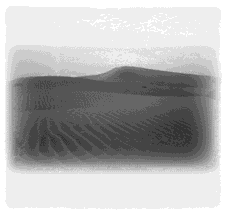|
Initial Contacts with the British
|
The Trucial Oman was never a single entity with a recognised ruler. It was a collection of disparate Sheikhdoms with different needs and aspirations and each of which dealt with the British in their own way and to suit their own needs. Before the British arrived on the scene, this stretch of coast had been under the influence of the Portugese, the Omanis and then the Persians. The last of these were to be displaced by two tribal confederations that were beginning to exert power in the area: The Qawasim and the Bani Yas. The Qawasim were a seafaring clan based in Ras Al-Khaimah, whereas the Bani Yas were a Bedouin tribe from the interior. The initial contacts of both of these tribes with the British was to be a confrontational one, but for different reasons.
The Qawasim were arch-rivals of the Al-Busaids who were based in Oman and who also sought to assert their control over this part of Arabia. In 1798, the British signed an agreement with the Al-Busaids in an elaborate attempt to keep the French out of the area and so strengthen Britain's claims to paramountcy in the Indian sub-continent. However, this deal with the Al-Busaids made Britain part of the enemy as far as the Qawasim were concerned. This meant that British East India Company ships were fair game and were attacked and pillaged at every opportunity by the Qawasim. This stretch of coast soon came to be known in Britain, India and beyond as the Pirate Coast and the Royal Navy reacted accordingly by launching campaigns and raids against the Qawasim in 1805, 1809 and 1811. Unfortunately for the British, the locals knew the area too well and could quickly escape only to regroup elsewhere.
In 1819, the British decided to try and end the piracy in this area once and for all. A large fleet was dispatched from Bombay and by 1820 it had destroyed and captured every Qawasim ship that it had come across and occupied all the major forts in the area, even going so far as occupying Qawasim hideouts in Persia itself. With the successful outcome of this operation the British imposed a General Treaty of Peace on nine Arab sheikhdoms in the area and installed a garrison in the region.
The treaty did not prevent these princes and sheikhs from continuing to attack each other, which they did with gusto and much to the consternation of the British. In an attempt to reign in the worst excesses of dynastic and tribal rivalry the British imposed a new treaty in 1835. It was named the Maritime Truce and its intended aim was to keep traffic moving in the Gulf region. It was revised in 1839 to include the forceful banning of slavery. In 1853, the truces were upgraded still further to become the Treaty of Peace in Perpetuity. Under which, the British assumed all responsibility for arbitrating in any disputes between the Sheikhs of the area. It was this final truce that gave this part of the Gulf its name for the next 120 years.
Meanwhile, partly as a result of the above treaties, the Bani Yas tribal confederation had also raised the ire of the British. These Bedouins quickly took over the maintenence of the slave trade routes as the Royal Navy successfully removed the ocean-going trading. The British kept a watchful eye on the activities of this tribe forcing the trade further and further inland but unable to stamp out the trade itself.
|
|
Establishment of Formal Relations
|
|
In the 1890's the British sought to formalise many of their agreements made with Sheikhs and rulers throughout the Gulf region. The reason for this was a way of forestalling renewed interest in the region by the Russians and the French. It is unclear how serious these intentions would have been followed through but for the British their links to India were to be maintained at all costs and the Trucial rulers were to be no exception to this rule. The British would provide protection for the Sheikhs in return for promises by these rulers that they would have no dealings with any foreign rulers without the express permission of the British.
This promise of protection served the rulers in one crucial aspect just after the end of The Great War. At this time in history Ibn Saud was busy uniting the interior of Arabia and sweeping all before him. The British promises of protection made Ibn Saud hesitate and ultimately bypass this region from his series of conquests. In return, this part of the British Empire was to be an extremely quiet and peaceful one. Exactly the way the British wanted it to be.
|
|
Administration
|
|
Despite the formal protectorate status of this stretch of coast the British didn't make much of an effort to control the domestic and commercial activities of these sheikhdoms. As far as the British were concerned, as long as the lines of communication with India were secure, this area was of little strategic or commercial importance. They therefore left the rulers to themselves without any British Political Agent being appointed until the outbreak of the Second World War.
British stakes and interest in the area were to be increased with the discovery of oil. It also had the effect of renewing competition and rivalry between the various sheikhs of the area as they each tried to maximise their territories in the hopes of receiving more wealth from oil.
One interesting anecdote is the way the British tried to resolve these border difficulties by sending a British diplomat out on his camel to ask local village heads, tribal rulers and Bedouins which sheikh they owed allegiance to. However, even this attempt failed, so the British set up a Trucial States Council in 1951 under the direct chairmanship of the British Political Agent in Dubai. This council was the direct ancestor of the present day UAE Supreme Council.
|
|
Role within the Empire
|
|
British links to the coast were to remain extremely limited for most of their history with one another. The Indian based British Steamship Line served British, Indian and local traders in the region firstly by serving Linagh but after 1903 transferring their port of call to the up and coming hub of Dubai. The only official British facilities were not to be built in the area until 1932 when Imperial Airways built a rest house in Sharjah for passengers and crew en route between London and India.
The discovery of oil was to change the strategic and economic significance of this imperial outpost. The first oil concession was from the poorest of the sheikdoms, Abu Dhabi to the British owned Iraq Petroleum Company in 1939. However, the Saudis would lay claim to the area of this first concession and relations between these states would sour considerably. It was only when Trucial Omani troops, commanded by British officers, drove the Saudis out of the disputed area that the matter was settled. This held up production for some years in this sector, but the importance of these fields were to be eclipsed when an enormous reservoir of oil was discovered off the shore of Abu Dhabi by an Anglo-French consortium. Exports began in 1962 and Abu Dhabi quickly became the leading sheikhdom in the region. Dubai was also fortunate enough to discover some oil, however the other sheikhs were not so lucky and they quickly beat a path to their oil rich neighbours.
The newly found wealth was beyond the financial understanding of the sheikh of Abu Dhabi as he spent his money foolishly and unwisely. In addition, he openly admitted that he did not trust banks and, most worryingly of all for the British, that he distrusted foreigners and foreign companies. The British conspired with his brother and the other sheikhs to have this troublesome ruler removed in 1966. This bloodless coup was to be the last major political undertaking by the British in the area.
|
|
Withdrawal from Empire
|
|
In 1968, the British announced that they would completely withdraw from the Gulf region by the year 1971. This sent the Trucial rulers into a frenzied series of negotiations with each other and with the other British protectorates; Qatar and Bahrain. The British tried to join these areas into a single autonomous country but the respective rulers could not agree on boundaries or political representation in the new grouping. Bahrain and Qatar were particularly aggrieved and left to become independent nations. The Trucial sheikhdoms were prepared to enter a federation with Abu Dhabi and Dubai (in that order) as having the heaviest political weighting, representation and most importantly of all for the smaller sheikhdoms, the heaviest financial obligations. With this formula the United Arab Emirates was formed in December 1971.
|
|
|
| Maps of Trucial Oman
|

|
|
n.b. The map of Trucial Oman was a constantly fluctuating one with ill-defined borders, shifting allegiances and with little geographical knowledge of the interior.
|
1660 Map of the Middle East
1765 Map of the Middle East
|
| Imperial era flags of Trucial Oman
|

|
|
n.b. All Gulf Sheikhdoms were requested by the British to include the colour white in their flags in order to signify that they had signed the Anti-Piracy Treaties.
|
| Images of Imperial Trucial Oman
|

|
|
Historic Trucial Oman Images
|
| Articles
|
Britain's Arabian Oil Empire
David Holden gives an account of how Britain's involvement in the Middle East mutated from a Nineteenth Century concern about security of maritime trade routes and the defence of India into a Twentieth Century preoccupation of guarding the flow of oil and attempts to contain rising nationalist aspirations in the region.
|
| Timeline
|
|
1793
|
Bani Yas move from interior to Abu Dhabi
|
|
1798
|
The Omani Al-Busaids sign agreement with British. The Qawasim begin attacking British ships
|
|
1805
|
Royal Navy raid against Qawasim
|
|
1809
|
Royal Navy raid against Qawasim
|
|
1819
|
Royal Navy launch large scale action against Qawasim bases and ships
|
|
1820
|
Royal Navy impose General Treaty of Peace on nine Sheikhdoms
|
|
1835
|
Maritime Truce imposed by British
|
|
1839
|
British force Sheikhs to ban slavery
|
|
1853
|
Treaty of Peace in Perpetuity signed
|
|
1892
|
Britain signs exclusive agreements with Sheikhs
|
|
1903
|
British Steamship Line moves to Dubai instead of Sharjah
|
|
1932
|
Imperial Airways opens rest house in Sharjah
|
|
1939
|
Abu Dhabi grants oil concession to Iraq Petroleum Company. No oil discovered.
|
|
1940
|
Political agent assigned to Dubai
|
|
1947-49
|
Border dispute between Abu Dhabi and Dubai. Abu Dhabi wins.
|
|
1949
|
Saudi Arabia claims Abu Dhabi's Buraimi oasis
|
|
1952
|
Saudi Arabia occupies Abu Dhabi's Buraimi oasis
|
|
1953
|
Abu Dhabi grants oil concession to Anglo-French consortium
|
|
1955
|
Trucial Omani forces drive Saudis from Buraimi oasis
|
|
1958
|
Anglo-French consortium discover enormous oil reserves
|
|
1962
|
Abu Dhabi oil exports begin
|
|
1966
|
Dubai discovers oil
Abu Dhabi's Sheikh overthrown by his brother with British help
|
|
1968
|
Britain declares intention to withdraw.
|
|
1971
|
Independence granted
|
|
|
Suggested Reading
|
The Ottoman Gulf
by Fred Anscombe
The Parting Years: A British Family and the End of Empire
by Sheila Bevan
Uncivil Servant: John Butter in India, Pakistan, Kenya and Abu Dhabi
by John Butter
|
|
